Best of Things, Gravel-Bikes -
The 7 Best Gravel Bikes Under $1500 in 2020
Looking for a budget bike to join the gravel bandwagon?
With gravel riding gaining popularity in recent years, more and more manufacturers are coming up with options across all price points.
These days, you can find a decent gravel bike for under $1,500. But be warned, don’t expect a carbon bike with electronic shifting. Those are at a much higher price point!
Here I’ll discuss what you can expect in a gravel bike in the $1,500 range and share some of the best options available.
A Quick Glance : Our Favorite Budget Gravel Bikes
| Bike Model | Frame | Groupset | Tire Size | Weight |
|---|---|---|---|---|
| Trek Checkpoint AL3 | Aluminum | Shimano Sora, 9 Speed | 700 x 32c | 10.5 kg / 23.1 lbs |
| Giant Revolt 2 | Aluminun | Shimano Sora, 9 Speed | 700 x 38c | 11.2 kg / 24.7 lbs |
| Cannondale Topstone | Aluminum | Shimano Sora, 9 Speed | 700 x 37c | 10.3 kg / 22.7 lbs |
| Salsa Journeyman 1 | Aluminum | SRAM Apex, 11 Speed | 700 x 37c | 11.0 kg / 24.2 lbs |
| Jamis Renegade S3 | Steel | Shimano GRX, 10 Speed | 700 x 36c | 11.0 kg / 24.2 lbs |
| GT Grade Expert | Aluminum | Shimano 105, 11 Speed | 700 x 37c | 9.5 kg / 20.9 lbs |
| Marin Gestalt 1 | Aluminum | Shimano Sora, 9 Speed | 700 x 32c | 10.4 kg / 22.9 lbs |
Trek Checkpoint ALR 3
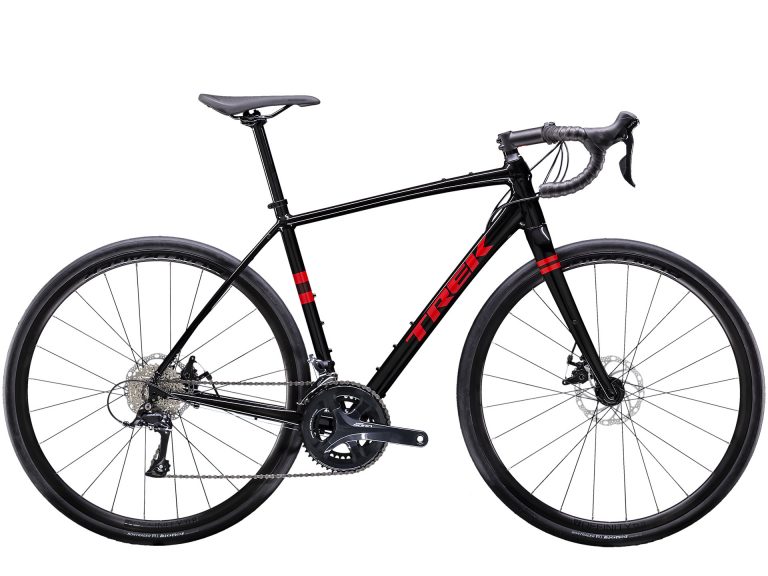
A Worthy Entry Level Option
- Frame : Aluminum
- Groupset : Shimano Sora, 9 Speed
- Weight : 10.5 kg / 23.1 lbs
There’s a lot to like about Trek’s entry-level model.
There’s the all-Shimano drivetrain, for starters, and flat mount disc brakes. Then there’s the Checkpoint’s aluminum alloy frame, which is made from Trek’s advanced 200 Form alloy and features internal cable routing to keep things tidy. There’s also a carbon fork for road dampening.
And let’s not forget the tubeless-ready Bontrager TLR Road rims. There’s a general expectation that a gravel bike, unlike other bike classes, will allow you to do a lot of different types of riding from bikepacking, to cross-country trail riding to commuting.
The Trek Checkpoint ALR 3 fulfills that need with plenty of places to mount bottle cages and bike racks. Altogether, this makes for an excellent starter bike for any cyclist’s first foray into the world of gravel.
- Pros : Excellent value for those starting out in gravel riding.
- Cons : 9-speed drivetrain is a little outdated.
Giant Revolt 2
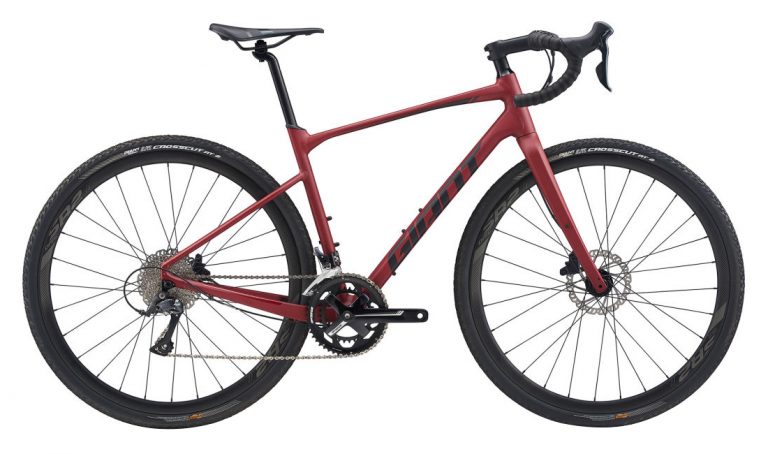
Ride Further with Giant's Endurance Oriented Geometry
- Frame : Aluminum
- Groupset : Shimano Sora, 9 Speed
- Weight : 11.2 kg / 24.7 lbs
If you’re looking for a way to get into the up-and-coming discipline that is gravel cycling, look no further than the Giant Revolt 2.
The badass looks of the Giant Revolt 2; it looks like a road bike gone rogue makes this one mean-looking bike. But this bike isn’t just about looks.
The Giant Revolt 2 is equipped with plenty of great options, including a full Shimano Sora drivetrain with a 9-speed rear cassette and a 48/32T crankset. This setup gives it plenty of gears for pavement or gravel.
A set of 700x38c gravel tires provide plenty of grip for off-road terrain. The dropped seat stays add compliance and maneuverability while longer chainstays keep the bike stable on uneven terrain.
- Pros : Hydraulic disc brakes provide plenty of reliable braking power.
- Cons : 9-speed drivetrain can be a little outdated.
Cannondale Topstone
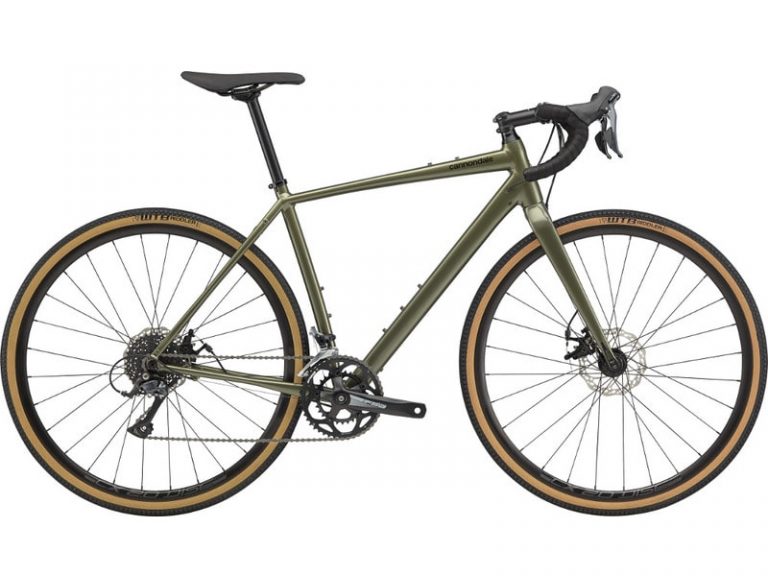
A Very Versatile Bike to Explore the Routes Less Traveled
- Frame : Aluminum
- Groupset : Shimano Sora, 9 Speed
- Weight : 10.3 kg / 22.7 lbs
While aluminum has long since been replaced by carbon at the top of the bike frame market, aluminum frames are still ubiquitous in the world of entry-level cycling, and Cannondale still makes some of the best of them.
The Cannondale Topstone’s aluminum frame makes for a stiff yet compliant ride with a carbon fork absorbing bumps. It also achieves stability with a longer wheelbase while maintaining excellent maneuverability thanks to a wheelset that is fitted with 37c WTB Riddler Comp tires.
Like many of its peers, the Cannondale Topstone is ready for adventure. Allen bolts dot the entire frame, providing plenty of mounting points for bikepacking, racks, and an extra bottle cage.
- Pros : Allen bolts dot the entire frame, providing plenty of mounting points for bikepacking, racks, and an extra bottle cage.
- Cons : Expect to pay a slightly higher price compared to the rest.
Salsa Journeyman 1
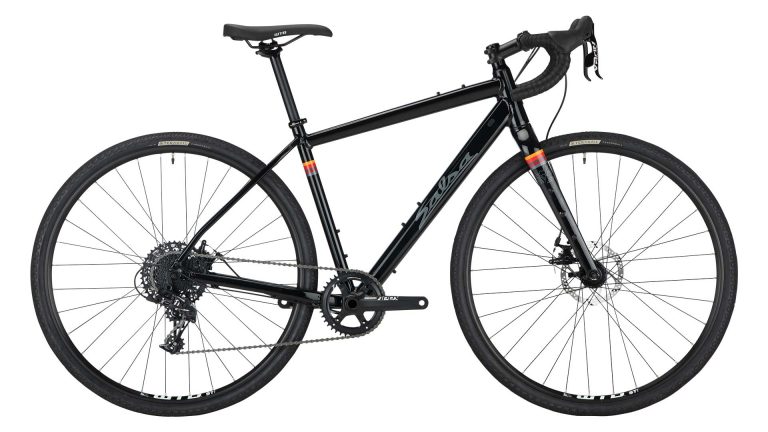
A Great Beginner Option for Weekend Adventures
- Frame : Aluminum
- Groupset : SRAM Apex, 11 Speed
- Weight : 11.0 kg / 24.2 lbs
Bikes are an expensive habit, especially if you’re into a lot of different cycling styles. With that in mind, it’s nice to find a bike that meets a lot of cycling needs.
That’s exactly what the Salsa Journeyman 1 does.
The Salsa Journeyman 1 is a great entry-level bike for a day on gravel trails or a weekend bike-packing trip. It’s clear that the aptly-named Journeyman is focused on adventures. The frame features rack mounts not just in the usual places but on the fork and top tube as well, offering plenty of places for bags, water bottles, racks, and fender mounts.
Its frame geometry facilitates a more comfortable upright ride. And while that makes it less suited for racing or single track, it does make for an excellent option for those looking to break into gravel riding.
- Pros : Conservative frame geometry makes a more comfortable ride especially for beginners.
- Cons : Color scheme can be boring for some.
Jamis Renegade S3
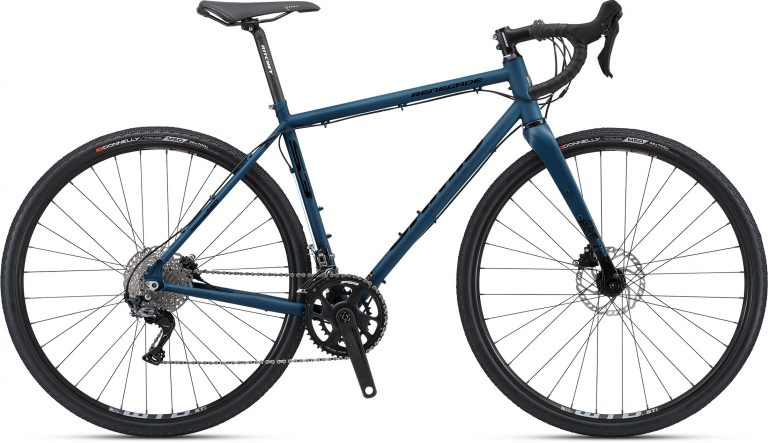
A Solid, Dependable, Old School Steel Bike
- Frame : Steel
- Groupset : Shimano GRX, 10 Speed
- Weight : 11.0 kg / 24.2 lbs
Although not nearly as common as aluminum framesets, you do still find some with steel frames. And many of them are quite good.
The Jamis Renegade S3 is one of those.
The frame is made from Reynolds 520 Chromoly steel with a carbon fork that adds both stiffness and shock absorption. What you’ll get with the Jamis Renegade S3’s steel frame is compliance that makes for a comfortable ride as well as superior strength.
This is a bike focused on adventure riding. That’s apparent in the numerous mounts for racks, bottle cages, and fenders. The Jamis Renegade S3 is heavier than most gravel bikes, though surprisingly light given its steel frame.
- Pros : Durable steel frame makes a comfortable ride feel.
- Cons : Heavier than its peers.
GT Grade Expert
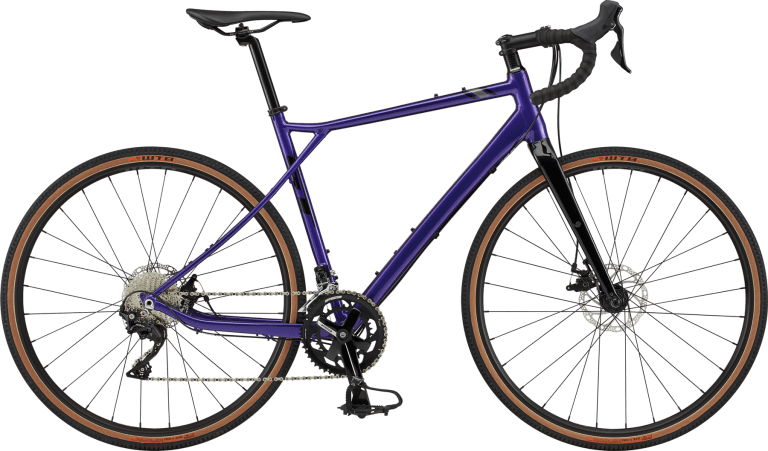
Ride the Roughest Gravel Surfaces with A Very Compliant Bike
- Frame : Aluminum
- Groupset : Shimano 105, 11 Speed
- Weight : 9.5 kg / 20.9 lbs
One thing you can count on with off-road bike specialists GT Bikes is that they aren’t afraid to take liberties with frame design. That’s in large part because the company has made its name off of innovation, namely the triple triangle frame design it came up with back in the 1990s.
That same design is present in all of its bike designs today, including the GT Grade Expert, which features floating seat stays designed to provide more vertical compliance and hence a more comfortable ride.
Couple that with a bottom bracket that’s so low the chainstay needs to curve downward to meet it, and you’ve got a ride that’s both compliant and stable. GT also finds ways to outfit its bikes with quality components at a budget price, and that’s the case here.
- Pros : Features an 11-speed Shimano 105 groupset, a level typically unheard of at this price point.
- Cons : Limited color choices.
Marin Gestalt 1
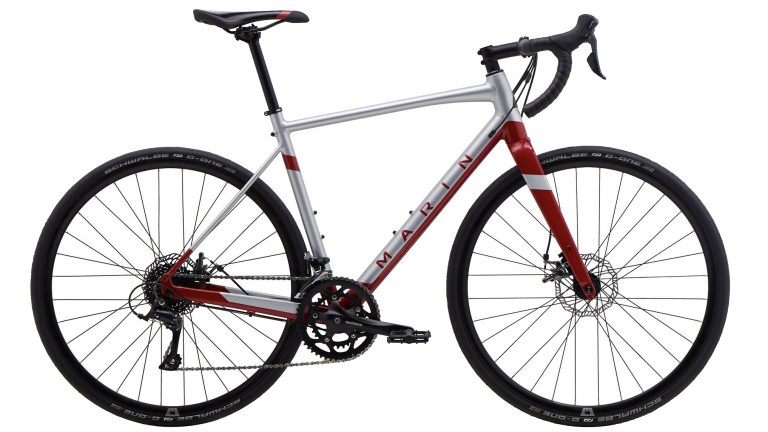
Incredible Value at an Affordable Price Levels
- Frame : Aluminum
- Groupset : Shimano Sora, 9 Speed
- Weight : 10.4 kg / 22.9 lbs
The German word gestalt is the idea that an object is greater than the sum of its individual parts. That might just be true for the Marin Gestalt 1, which gives incredible value through its versatility.
A drop bar, 32c tires, and relaxed head tube angle lets you take on a windy single track, making the Gestalt at home not just on gravel but flowy trails as well. The Marin Gestalt 1 also won’t leave you struggling on long off-road climbs thanks to its dropper seat post. It’s no slouch on the road either with a stiff frame that gives the Gestalt a responsive feel.
And for those adventure enthusiasts and commuters, there’s also plenty of mounts for racks. The Marin Gestalt 1 is fitted with a solid set of components with a Shimano Sora, 9-speed drivetrain, and Tektro disc brakes.
- Pros : Dropper seatpost provides added versatility when riding over rough off-road terrains.
- Cons : Mix and match between Shimano and Tektro components to bring the overall cost down.
What to Expect in a Gravel Bike Under $1,500
Low-end models are generally designed to give you plenty of bang for your buck. What does this mean?
Bikes at this price point are multi-use with most designed to take on more than just gravel trails. Some allow for moderate trail riding while others are set up to facilitate touring and bike packing.
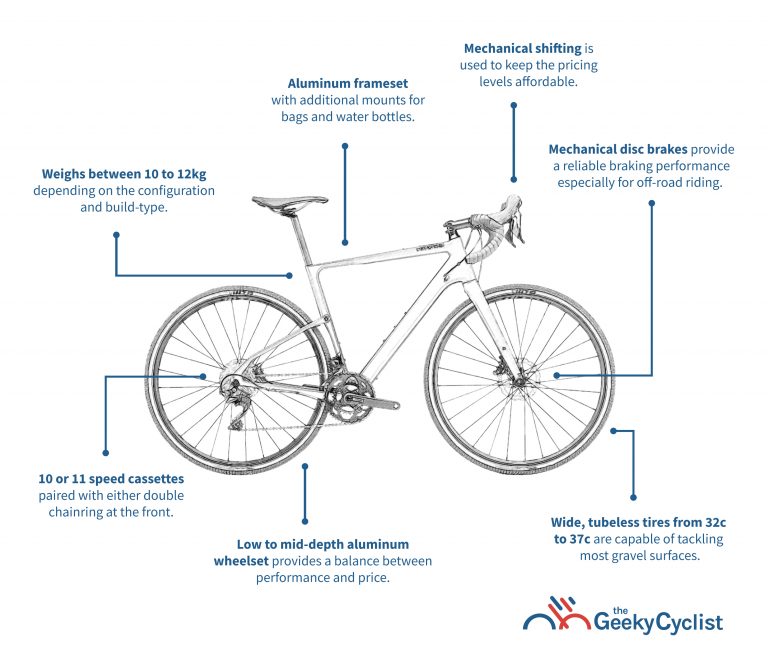
1. Aluminum Bike Frame
The vast amount of frames you’ll see at the sub $1,500 level will be aluminum although you will find the occasional steel frame, such as with the Jamis Renegade S3.
Aluminum is cheap, relatively lightweight and strong enough to support off-road riding.
Most entry-level models will complement their aluminum frames with carbon forks, which add stiffness as well as shock absorption for the handlebars.
For those that lean toward adventure ridings, such as the Salsa Journeyman 1 and Cannondale Topstone, expect to find plenty of mounts for rear bike racks, handlebar bags, fenders, and bottle cages on the top tube, fork, and seat stays.
Some frames at this price point even offer design touches typically reserved for high-end models. Trek and Cannondale for example, have internal cable routing on their entry-level models.
2. 2x Drivetrain with 9 or 10 Speed
As with mountain-bikes, gravel bikes have fully embraced 1x drivetrains, which make up the vast majority of bikes at the high end.
At the low end; however, expect to find predominantly 2x drivetrains. Why?
2x gearing offers more gears, which better suit the needs of entry-level riders by making off-road climbs easier. And, of course, 2x drivetrains are generally cheaper, helping bike manufacturers to keep the overall price down.
That’s not to say there aren’t some exceptions.
For example, the Salsa Journeyman 1 is equipped with SRAM’s entry-level groupset, the SRAM Apex 1x.
Keeping cost in mind, most groupsets will be of the entry-level variety with Shimano Sora, Shimano Tiagra, and SRAM Apex dominating the field. However, there are some notable exceptions here as well.
For example, the GT Grade Expert is fitted with a full 11-speed Shimano 105 groupset.
3. Mechanical Disc Brakes
You’ll find a mix of mechanical and hydraulic disc brakes at this price point. Mechanical disc brakes engage the brake calipers via cables.
Hydraulic disc brakes, like an automobile, use brake fluid to create pressure that engages the brakes.
What’s the difference?
Hydraulic brakes are superior for two reasons.
For one, they offer better overall braking power.
Secondly, they also are easier to modulate, allowing you to apply varying degrees of brake pressure more easily. This translates into more gradual, less jerky braking. This, of course, means that hydraulic brakes are more expensive.
At the entry-level price point expect to find mostly mechanical brakes. As with components, there are bike manufacturers that look to add value to their bikes by equipping them with hydraulic brakes.
Giant, for example, offers hydraulic brakes with their Giant Revolt 2.
4. Tire Sizes From 32c to 37c
You’ll find a couple of options when it comes to wheel size at this price point.
Most entry-level gravel bikes will feature 700c wheels with tires ranging from 32c to 37c.
However, you will find some bikes that use the smaller 650b rim for their wheelsets. The 650b size allows for wider gravel tires ranging in size from 42c to 47c.
What’s the difference?
Wider tires absorb more shocks and generally provide better traction, facilitating rides on more technical off-road terrain.
The compromise is speed. Narrower tires are lighter weight and offer a better roll.
It’s also important to consider tubeless vs. clincher rims. Not all rims are tubeless compatible at this price range. This is significant because this is likely an area you’ll want to upgrade at some point.
Tubeless tires reduce the likelihood of flats and can be run at lower tire pressures, both huge advantages when riding off-road. Bikes such as the Trek Checkpoint ALR 3 are fitted with tubeless-ready rims.
5. Total Weight between 10 to 12 kg
Given the fact that bikes in this price range are limited to aluminum frame materials, lower-end wheelsets, and entry-level component sets, expect the overall weight to be markedly higher compared to high-end models.
The total weight for bikes in the $1,500 range will be somewhere between 10 and 12 kg.
The Cannondale Topstone and Marin Gestalt 1 offer some of the lighter weight frames in this class at just over 10 kg while the Jamis Renegade S3 weighs in towards the higher end of this range at 11 kg.
Author Recommended Reads
